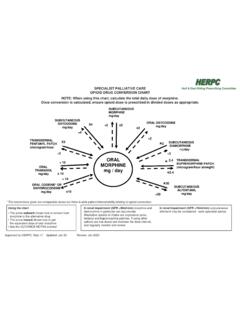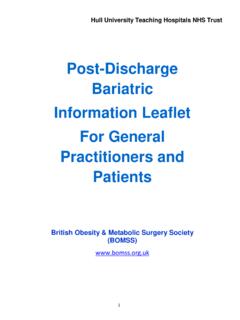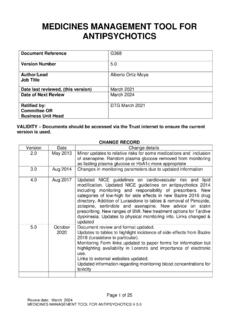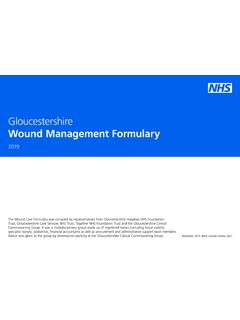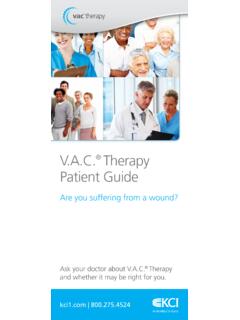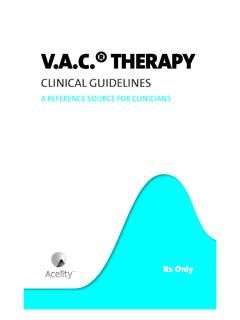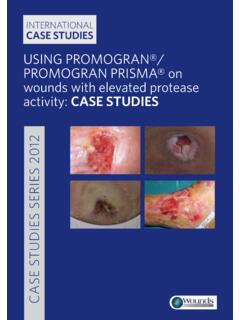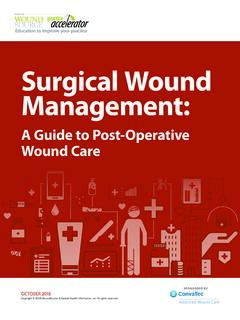Transcription of Wound Management Formulary - Hull University Teaching ...
1 Wound Management Formulary Reference No: 936 Version: 1 Author: Zena Scott Second Author First Issued On: 30th June 2019 Latest Issue Date: 30th June 2019 Review Date: 30th September 2021 Referenced Documents: Ratified By: Therapeutics & Pathway Group Distribution: Document Revisions Date Author Nature of Change Reference This document can be found on My Compliance Please make sure you use the most current version. CITY HEALTH CARE PARTNERSHIP CIC (CHCP) Wound Management Formulary (2019) This Wound Management Formulary outlines for clinicians (nurses and podiatrists) employed by CHCP the Wound care products available to them through the total purchasing process for the Management of wounds in adults. This process is to be used for patients registered with a GP in the Hull CCG and East Riding of Yorkshire CCG area. This Formulary may be used as a guide by other services in the area ( 0 19 service; GP practices) but funding via the total purchasing process is provided by the CCGs for adult Wound Management by CHCP clinicians as outlined in this Formulary .
2 The standardisation of ordering and use of Wound care products across CHCP is to ensure that clinicians are able to justify their decision making and expenditure on Wound care products, after considering the efficacy, safety, patient acceptability and costs of the Wound care product. Treatment should be selected on the grounds of current clinical opinion, the clinician s holistic/ Wound assessment and available evidence of clinical effectiveness. Details of the Management plan must be recorded in the patient s electronic record on SystmOne. Clinicians must order Wound care products that are on the CHCP Wound Management Formulary from NWOS using the online Formeo system. For Wound care products that are marked on the Formulary requiring Clinical Reasoning it is the responsibility of the prescribing nurse to complete this form and record in the patient s electronic record. The clinician completing the Clinical Reasoning form must inform the TV Link Nurse or identified clinician within the team who has responsibility for monitoring the process or the Tissue Viability Nurse (Hull and East Riding) where appropriate.
3 If all CHCP Wound Management Formulary choices have been exhausted and/or satisfactory outcomes has not been achieved, practitioners may select other products outside of the Formulary . Where possible these product(s) should be obtained through an NHS Nurse Prescriber prescription only (V100/V150/V300 prescribers). In all cases the clinician must have supporting evidence and a documented clear rationale for the choice. The process for updating new Wound care products on the Formulary will be reviewed regularly to reflect innovation in practice and new products. The Wound Management Formulary can be accessed via My Compliance 2 Guidelines to Generic Wound Care Range Wound Type Necrotic Sloughy Granulating Infected Epithelialising Fungating/ Cavity Malodorous Necrotic wounds are characterised by black dead tissue. Mixture of dead white cells, dead bacteria, rehydrated necrotic tissue and fibrous tissue.
4 Granulating tissue usually pink in colour at the base and bumpy (granular) appearance. Friable, dark red granulation tissue. Increased. Malodour. Increased pain. Delayed healing. Satellite lesions. Typified by pink /pale mauve coloured tissue. Has an offensive odour indicating infection or colonisation of bacteria. Often palliative patients may have a fungating Wound . Wound extends to tissues deep into the epidermis and dermis. Treatment Aim To soften and remove necrotic tissue by rehydration and debridement to allow granulation. To soften and remove slough by rehydration and debridement. To maintain ideal environment for granulation. To control and manage infection. To protect epithelialising tissue until established. To promote an ideal environment for epithelialisation and contraction. To manage odour, bleeding and exudate. ( Wound Bed must be protected with a non-adherent dressing to prevent adherence of other dressings ).
5 Antibiotics must be used only when appropriate) To promote granulation from the base of the Wound . 3 NO EXUDATE Hydrogel/sheet (P)* Hydrogel/sheet (P) Non-Adherent dressing (P) Identify Wound infection as per Protocol/Pathway: Contaminated Colonised Local Infection Spreading Infection Systemic Treat with the appropriate Topical antimicrobial and or antibiotics. Film (P) Non-adherent Dressing (P) Foam Dressing (P & S) Absorbent Pad (S)* Topical Antimicrobial (P) Charcoal Dressing (S) Gelling Fibre (P) Foam (S) Absorbent Pad (S) LOW EXUDATE Hydrogel/sheet (P) Hydrogel/sheet (P) Foam (P) Absorbent Pad (S) Non-Adherent Dressing (P) Low Adherent Pad (P) Foam (P) Absorbent Pad (S) Non-adherent Dressing (P) Gelling Pad (P) Alginate (P) Foam Dressing (P & S) Absorbent Pad (S) Antimicrobial (P) Charcoal Dressing (S) Gelling Fibre (P) Alginate (P) Foam (S) Absorbent Pad (S) MODERATE TO HIGH EXUDATE (Do not use hydrogel on high exudating wounds Gell Fibre dressing (P) Foam or Absorbent Pad (P & or S) Gell Fibre dressing (P) Foam or Absorbent Pad (P & or S) Gelling Fibre (P) Alginate (P) Foam (P & S) Foam (P) Absorbent Pad (S) Non-adherent Dressing (P) Foam Dressing (P & S) Absorbent Pad (S) Antimicrobial (P) Charcoal Dressing (S)
6 Gelling Fibre (P) Alginate (P) Foam (S) Absorbent Pad (S) * (P) Primary dressing (S) Secondary dressing All patients must have an individual holistic assessment followed by a comprehensive Wound assessment to develop a treatment plan that is patient specific for their needs. All wounds must be re-assessed minimum every 4 weeks or there are any changes in the Wound . These assessments are the key to a successful outcome for patients who have acute or chronic wounds. It is the clinician s responsibility to identify intrinsic factors diabetes/ischaemia/compliance, on any Wound that is acute/chronic or complex as these will influence the potential for that Wound to heal. Realistic goals and outcomes must be discussed. Patient who have an identified Wound infection clinicians must refer to the Wound Infection Protocol and pathway and have supporting evidence in the patient record on the use of products, discontinuing products and why products have not been used.
7 4 Wound Management Formulary A Formulary of Wound Management products is a clinical and financial necessity in the National Health Service (NHS) today and it is the responsibility of Management and the healthcare professional to work within financial constraints and provide effective and cost efficient Wound care. The Wound Management Formulary (WMF) is to support the process of total purchasing for Wound care products and has the explicit aims to: Maintain patient safety in Wound Management . To promote continuity of care and rational prescribing. Audit the use of Wound care dressings that will direct education and training of healthcare professionals in the organisation. Provide a process to review all new Wound products for future use in clinical practice. Provide an education programme that supports the appropriate use and application of dressings that will optimise benefits to patients.
8 Wound care products selected for this Formulary is based on: A multi-professional approach with community healthcare professionals: o medicine Management o tissue viability group o organisation Management . Up to date research evidence on Wound Management . Current prescribing of healthcare professionals in primary care. The key to successful Wound Management is the accurate holistic and Wound assessment of each individual patient. A clinician undertaking Wound care should include the Wound assessment tool within the assessment process. This tool builds on Wound bed preparation and help to structure the clinicians approach to Wound Management . It is an acronym for: T Tissue I Inflammation or infection M Management of exudates E Edges of the Wound 8 CITY HEALTH CARE PARTNERSHIP CIC Wound Management Formulary (July 2019) NURSING SERVICES CATEGORIES PRODUCT AVAILABLE TO ALL PRACTITIONERS PRODUCTS AVAILABLE REQUIRING CLINICAL REASONING (follow Pathway) FP10 PRESCRIPTION SUPPLY AND CLINICAL REASONING Cleansing Agent Irripod Sterile Saline Pods Low Adherence dressings Atrauman ActivHeal Silicone Wound Contact Layer Absorbent dressings (Suitable for low to moderate exudate) Softpore Absorbent Dressing Pads Sterile Zetuvit E Hydrogel ActivHeal Hydrogel Hydrogel Sheets ActiFormCool Superabsorbent Kliniderm Cutimed Sorbion Sachet Cutimed Sorbion XL Hydrocolloids ActivHeal Hydrocolloid Foam Backed (concave & sacral) Hydrocoll Border Hydrocoll Thin (non-border)
9 Vapour Permeable Film Hydrofilm Leukomed - T Alginates ActivHeal Alginate ActivHeal Alginate Rope Gelling Fibre filler ActivHeal Aquafiber Extra & Ribbon Durafiber & Ribbon Adhesive Foams Allevyn Adhesive Foam Non-Adhesive Foams Allevyn Non-Adhesive Foam ActivHeal Foam Heel Dressing Silicone Foam dressings Allevyn Gentle Border Range including Multisite Kliniderm Foam Silicone Border Allevyn Life Skin Protectors Cutimed Protect (including cream, foam & spray) Surgical Tapes Micropore Other Tapes CliniTape Clear (Latex Free) Mefix Charcoal dressings Odolock Protease- Modulating Matrix dressings UrgoStart Contact UrgoStart Plus (incl Border) 9 Other Wound Care Accessories Softdrape Dressing Kit Debrisoft Pad Aderma Kerraped Woven and Fabric Swabs Gauze swab, 8-ply white sterile (Premier) Tubular Bandage, elasticated Actifast Compression Bandages Actico Comprilan Multi-layer Compression Bandaging K-Four (four layer system) K-Two (two layer system) Compression Hosiery and Garments Graduated Compression Hosiery Jobst FarrowWrap Topical Negative Pressure Therapy PICO Single Use Negative Pressure Wound Therapy System ANTIMICROBIALS It is the clinician s responsibility to use antimicrobials appropriately and as indicated in.
10 CHCP Protocol The Management of Wound Infection 2018 Antimicrobial dressings Iodosorb Ointment Inadine Antimicrobial Silver Silvercel Antimicrobial Silver Low Adherent dressing Acticoat Flex 3 Acticoat Flex 7 Antimicrobial with Hydrocolloid Dressing Aquacel Ag+ Extra Sheets & Ribbon Antimicrobial Soft Polymer dressing UrgoTul SSD Antimicrobial with Charcoal Other Antimicrobials Cutimed Sorbact Cutimed Sorbact Gel Cutmed Siltec Sorbact Medihoney Gel Medihoney HCS Medihoney Tulle Flaminal Forte Flaminal Hydro 10 Antimicrobial Solutions Prontosan Pods Renasys Touch Pump Negative Pressure Wound Therapy Devices Consumables Negative Pressure Wound Therapy devices loaned by Smith and Nephew Hull Order on FP10 East Riding Order direct from Smith and Nephew or via Formeo system and supply from base CITY HEALTH CARE PARTNERSHIP CIC Wound Management Formulary (July 2019) PODIATRY SERVICES Low Adherence dressings Atrauman Absorbent dressings Softpore Melolin Telfa Superabsorbent Kerramax Care Alginates ActivHeal Alginate Gelling Fibre Filler ActivHeal Aquafiber Extra Non Adhesive Foams Allevyn Non-Adhesive ActivHeal Foam Heel Dressing Silicone Foam dressings Allevyn Gentle Non-Border Allevyn Gentle Border Allevyn Gentle Border Lite Kliniderm Foam Silicone border Skin Protectors Cutimed Protect Tapes Mefix tape Protease Modulating dressings UrgoStart Plus Non-extensible Bandages Hospiform Support Bandages Hospicrepe 11 ANTIMICROBIALS It is the clinician s responsibility to use antimicrobials appropriately and as indicated in.
